Epic Showdowns: The Most Legendary Mythological Conflicts
I. Introduction to Mythological Conflicts
Mythological conflicts are epic battles or struggles between powerful beings, gods, heroes, and monstrous entities that often serve as the backbone of cultural narratives. These conflicts encapsulate the values, fears, and beliefs of societies, providing insight into their worldviews. They reflect the eternal struggle between order and chaos, good and evil, and fate and free will, making them pivotal in human storytelling.
This article focuses on some of the most legendary mythological conflicts, highlighting their significance in various cultures and their lasting impacts on literature and society.
II. The Titans vs. Olympians: The Clash of the Gods
One of the most notable mythological conflicts in Greek mythology is the Titanomachy, the ten-year war between the Titans, led by Cronus, and the Olympians, led by Zeus. This epic clash was not merely a battle for supremacy; it was a fundamental shift in power dynamics among the divine.
Key figures in this conflict included:
- Cronus: The leader of the Titans, who feared being overthrown by his children.
- Zeus: The youngest son of Cronus, who led the rebellion against the Titans.
- Hera, Poseidon, and Hades: Zeus’s siblings who played critical roles in the battle.
The Titanomachy had profound implications for Greek mythology, leading to the establishment of the Olympian gods as the primary deities and shaping subsequent tales of heroism, hubris, and the human condition.
III. Ragnarok: The Norse Apocalypse
In Norse mythology, Ragnarok signifies the end of the world, a cataclysmic event that leads to the death of many gods and the destruction of the cosmos. This apocalyptic battle is characterized by a fierce confrontation between the gods, led by Odin, and their enemies, the giants.
Major figures involved in this epic showdown include:
- Odin: The Allfather, who sacrifices himself for knowledge.
- Thor: The god of thunder, who faces the Midgard Serpent.
- Loki: The trickster god, whose betrayal leads to chaos.
- The Giants: Representing the forces of chaos and destruction.
The cyclical nature of destruction and rebirth is a core theme in Ragnarok, reflecting the belief in renewal and the inevitability of change in the universe.
IV. The Battle of Kurukshetra: Mahabharata’s Epic War
The Battle of Kurukshetra is a central event in the Indian epic, the Mahabharata. This great war was fought between the Pandavas and the Kauravas, embodying the conflict between righteousness and injustice.
Key warriors in this epic battle included:
- Arjuna: The heroic prince, faced with a moral dilemma before the battle.
- Bhishma: The revered elder, fighting for the Kauravas despite his personal beliefs.
- Karna: A tragic hero torn between loyalty and righteousness.
The moral dilemmas faced by the characters highlight the complexities of duty, honor, and the consequences of war, making the Battle of Kurukshetra a profound narrative on the intricacies of human nature.
V. Gilgamesh vs. Humbaba: The Quest for Immortality
The Epic of Gilgamesh is one of the oldest literary works, detailing the adventures of Gilgamesh, the King of Uruk. A significant confrontation occurs between Gilgamesh and Humbaba, the monstrous guardian of the Cedar Forest.
Humbaba represents the natural world and the fear of the unknown. His defeat by Gilgamesh symbolizes the human quest for immortality and the struggle against the inevitable fate of mortality. The themes of heroism and the search for meaning in life resonate deeply throughout their confrontation, showcasing the tension between civilization and nature.
VI. The War of the Roses: The Egyptian Gods’ Rivalry
In Egyptian mythology, the conflict between Set and Osiris embodies the struggle between chaos and order. Set, the god of chaos, murders his brother Osiris, who represents order and resurrection.
This rivalry symbolizes the eternal conflict within nature and the human psyche, where chaos threatens to disrupt the established order. The lasting influence of this myth is seen in the Egyptian belief in the afterlife and the importance of maintaining cosmic balance.
VII. The Duel of Aeneas and Turnus: Fate vs. Free Will
In Virgil’s Aeneid, the conflict between Aeneas, a Trojan hero, and Turnus, the leader of the Rutulians, symbolizes the struggle between fate and free will. This duel is the culmination of the epic narrative where Aeneas fights to fulfill his destiny of founding Rome.
Aeneas embodies the virtues of duty and perseverance, while Turnus represents personal ambition and valor. The themes of destiny and divine intervention are woven throughout their struggle, reflecting the complexities of human agency against the backdrop of predetermined fate.
VIII. The Fight of the Fomorians and Tuatha Dé Danann: Celtic Legends
In Irish mythology, the conflict between the Fomorians and the Tuatha Dé Danann represents the battle between the forces of chaos and the deities of civilization. The Fomorians, often depicted as monstrous beings, sought to dominate the Tuatha Dé Danann, who were associated with culture and prosperity.
Key figures in this legendary battle include:
- Bres: A Fomorian king who represents the struggle for power.
- Lugh: A hero among the Tuatha Dé Danann, symbolizing skill and leadership.
This conflict has significant cultural implications, reflecting the struggle for identity and the importance of community in Irish culture.
IX. The Epic Showdown of Beowulf and Grendel: Heroism and Grief
The epic poem Beowulf features a legendary confrontation between Beowulf, a noble warrior, and Grendel, a monstrous creature terrorizing the kingdom of Heorot. This conflict highlights the themes of heroism and the inevitable grief that accompanies the struggle against evil.
Beowulf’s decision to face Grendel without weapons demonstrates his courage and commitment to protecting his people. The battle serves as a metaphor for the human condition, where heroism often comes with personal sacrifice and loss.



